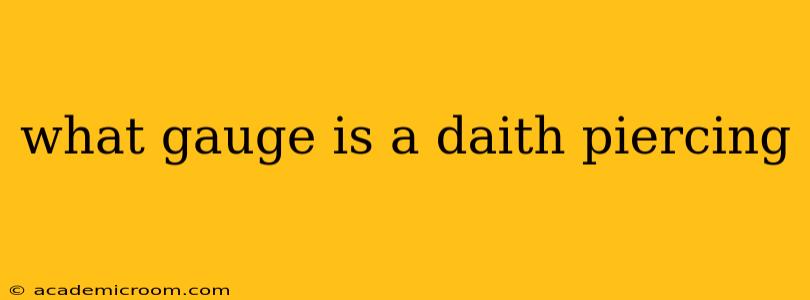The most common gauge for a daith piercing is 16 gauge. While other gauges can be used, 16g is the industry standard for several reasons, which we'll explore below. Choosing the right gauge is crucial for proper healing and minimizing complications.
Why is 16 Gauge the Standard for Daith Piercings?
The daith piercing, located in the inner cartilage fold of the ear, is known for its relatively thick cartilage. A 16 gauge needle (approximately 1.2mm in diameter) provides the ideal balance:
- Sufficient Space for Healing: A 16 gauge piercing allows enough room for the initial swelling that often accompanies a new piercing. Smaller gauges can lead to increased pressure and discomfort during healing.
- Reduced Risk of Migration: The thicker needle creates a wider channel for the jewelry to sit in, reducing the likelihood of the piercing migrating or rejecting the jewelry.
- Stronger Jewelry Options: A 16 gauge piercing accommodates a wider variety of jewelry styles and materials, giving you more options for your daith jewelry after the healing process is complete.
- Experience and Preference: Most experienced piercers prefer 16g for daiths because of its proven track record of successful healing and minimal complications.
What Other Gauges Might Be Used?
While uncommon, you might encounter a daith piercing done with a slightly different gauge:
- 14 Gauge (1.6mm): This is a larger gauge and is less commonly used for daiths, possibly for individuals with exceptionally thick cartilage or those who prefer a more substantial-looking piercing. However, it's generally not recommended due to the increased risk of trauma and longer healing time.
- 18 Gauge (1mm): This is a smaller gauge and is generally not advised for daith piercings due to the increased risk of migration, rejection, and difficulties in healing. The delicate cartilage of the daith may not be able to support a smaller gauge as effectively.
It is crucial to note: Always consult with a reputable and experienced piercer. They will assess your ear anatomy and determine the most appropriate gauge for your specific daith piercing. Don't hesitate to ask questions about their gauge preference and why they've chosen it for you.
What Gauge Jewelry Should I Use After Healing?
Once your daith piercing is fully healed, you might be able to downsize to a slightly smaller gauge if desired. However, this should always be done by a professional piercer who can ensure the correct size and fit. Improper downsizing can lead to complications. Sticking with 16 gauge jewelry is generally recommended for long-term wear in a daith piercing due to its strength and suitability for the piercing location.
What if my Piercing is Too Tight?
If you experience discomfort or tightness from your daith jewelry after healing, it's best to consult a professional piercer immediately. They can assess the situation and determine the best course of action. Never attempt to adjust or change your jewelry yourself, especially during the healing process.
Can I Choose the Gauge Myself?
No. The gauge of your daith piercing should always be determined by a qualified and experienced piercer who can evaluate your anatomy and advise on the best size for a safe and successful piercing.
Remember, choosing a reputable piercer is as important as the gauge itself. A professional piercer will use sterile techniques, provide proper aftercare instructions, and ensure your safety and the best possible outcome for your daith piercing.
